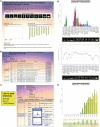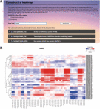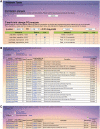RiceXPro: a platform for monitoring gene expression in japonica rice grown under natural field conditions
- PMID: 21045061
- PMCID: PMC3013682
- DOI: 10.1093/nar/gkq1085
RiceXPro: a platform for monitoring gene expression in japonica rice grown under natural field conditions
Abstract
Elucidating the function of all predicted genes in rice remains as the ultimate goal in cereal genomics in order to ensure the development of improved varieties that will sustain an expanding world population. We constructed a gene expression database (RiceXPro, URL: http://ricexpro.dna.affrc.go.jp/) to provide an overview of the transcriptional changes throughout the growth of the rice plant in the field. RiceXPro contains two data sets corresponding to spatiotemporal gene expression profiles of various organs and tissues, and continuous gene expression profiles of leaf from transplanting to harvesting. A user-friendly web interface enables the extraction of specific gene expression profiles by keyword and chromosome search, and basic data analysis, thereby providing useful information as to the organ/tissue and developmental stage specificity of expression of a particular gene. Analysis tools such as t-test, calculation of fold change and degree of correlation facilitate the comparison of expression profiles between two random samples and the prediction of function of uncharacterized genes. As a repository of expression data encompassing growth in the field, this database can provide baseline information of genes that underlie various agronomically important traits in rice.
Figures




Similar articles
-
RiceXPro version 3.0: expanding the informatics resource for rice transcriptome.Nucleic Acids Res. 2013 Jan;41(Database issue):D1206-13. doi: 10.1093/nar/gks1125. Epub 2012 Nov 23. Nucleic Acids Res. 2013. PMID: 23180765 Free PMC article.
-
RiceFREND: a platform for retrieving coexpressed gene networks in rice.Nucleic Acids Res. 2013 Jan;41(Database issue):D1214-21. doi: 10.1093/nar/gks1122. Epub 2012 Nov 24. Nucleic Acids Res. 2013. PMID: 23180784 Free PMC article.
-
Rice TOGO Browser: A platform to retrieve integrated information on rice functional and applied genomics.Plant Cell Physiol. 2011 Feb;52(2):230-7. doi: 10.1093/pcp/pcq197. Epub 2011 Jan 6. Plant Cell Physiol. 2011. PMID: 21216747 Free PMC article.
-
Rice Annotation Project Database (RAP-DB): an integrative and interactive database for rice genomics.Plant Cell Physiol. 2013 Feb;54(2):e6. doi: 10.1093/pcp/pcs183. Epub 2013 Jan 7. Plant Cell Physiol. 2013. PMID: 23299411 Free PMC article.
-
Field transcriptome revealed critical developmental and physiological transitions involved in the expression of growth potential in japonica rice.BMC Plant Biol. 2011 Jan 12;11:10. doi: 10.1186/1471-2229-11-10. BMC Plant Biol. 2011. PMID: 21226959 Free PMC article.
Cited by
-
A Novel Gene, OZONE-RESPONSIVE APOPLASTIC PROTEIN1, Enhances Cell Death in Ozone Stress in Rice.Plant Physiol. 2015 Sep;169(1):873-89. doi: 10.1104/pp.15.00956. Epub 2015 Jul 28. Plant Physiol. 2015. PMID: 26220952 Free PMC article.
-
Iron-binding haemerythrin RING ubiquitin ligases regulate plant iron responses and accumulation.Nat Commun. 2013;4:2792. doi: 10.1038/ncomms3792. Nat Commun. 2013. PMID: 24253678 Free PMC article.
-
Organ- and stress-specific expression of the ASR genes in rice.Plant Cell Rep. 2014 Jan;33(1):61-73. doi: 10.1007/s00299-013-1512-4. Epub 2013 Oct 2. Plant Cell Rep. 2014. PMID: 24085307
-
Increase in cellulose accumulation and improvement of saccharification by overexpression of arabinofuranosidase in rice.PLoS One. 2013 Nov 4;8(11):e78269. doi: 10.1371/journal.pone.0078269. eCollection 2013. PLoS One. 2013. PMID: 24223786 Free PMC article.
-
A fast, efficient and high-throughput procedure involving laser microdissection and RT droplet digital PCR for tissue-specific expression profiling of rice roots.BMC Mol Cell Biol. 2020 Dec 10;21(1):92. doi: 10.1186/s12860-020-00312-y. BMC Mol Cell Biol. 2020. PMID: 33302866 Free PMC article.
References
Publication types
MeSH terms
LinkOut - more resources
Full Text Sources
Other Literature Sources
Research Materials

